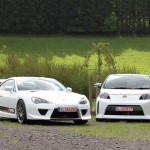Gazoo Racing is Toyota’s factory backed tuning company. Some of their  previous projects include a supercharged 6-speed iQ and a hybrid sports MR-S. They’ve just released news of a twin charged GT-86 / Scion FR-S / Subaru BRZ. Twin charged means that the engine has both a supercharger and a turbocharger. The supercharger boosts the engine while it’s still at low rpm’s and then the turbocharger takes over once it’s spooled up at high rpm. Generally speaking, this allows the use of a larger turbocharger since you don’t have to worry about turbo lag. The Toyota engineers went with the
previous projects include a supercharged 6-speed iQ and a hybrid sports MR-S. They’ve just released news of a twin charged GT-86 / Scion FR-S / Subaru BRZ. Twin charged means that the engine has both a supercharger and a turbocharger. The supercharger boosts the engine while it’s still at low rpm’s and then the turbocharger takes over once it’s spooled up at high rpm. Generally speaking, this allows the use of a larger turbocharger since you don’t have to worry about turbo lag. The Toyota engineers went with the  boxer engine layout for this car because it was the only way to get the sporty look of a low hood line, but it eliminated the possibility of AWD (no room for a front diff under the engine) for Subaru and didn’t leave space for a large air to air intercooler in front of the radiator. That’s why news of this twin charged car comes as a bit of a surprise. I think there was enough complaints about low power from the media reviews of the car to warrant them breaking a few traditions to make this happen. A closer look at the engine bay reveals a few interesting things.
boxer engine layout for this car because it was the only way to get the sporty look of a low hood line, but it eliminated the possibility of AWD (no room for a front diff under the engine) for Subaru and didn’t leave space for a large air to air intercooler in front of the radiator. That’s why news of this twin charged car comes as a bit of a surprise. I think there was enough complaints about low power from the media reviews of the car to warrant them breaking a few traditions to make this happen. A closer look at the engine bay reveals a few interesting things.
- The air enters the system through the intake box where there’s a stock style panel filter. The air moves through the black plastic pipe to the supercharger behind the engine.
- This looks to be a roots type supercharger that is driven by a shaft that runs across the top of the engine to the belt system at the front. The cylindrical cover directly under the number 2 hides the shaft. It looks like the pulley that drives the supercharger is peeking out from behind the blue coupling on the air box. The red pipe above the number 2 is the output of the supercharger where the air leaves after it’s been compressed.
- If you follow the red pipe out of the supercharger, it drops down into the corner of the engine bay where the turbocharger is hiding. The turbocharger isn’t visible, but if you look carefully you can see another red pipe behind the one that connects the supercharger and turbocharger. This is where the air leaves the turbocharger after it’s been compressed.
- The large aluminum box against the firewall is the air to water intercooler that cools the compressed intake air. The coolant used is piped to a radiator in the front of the car. The radiator for the air to water intercooler is smaller than an equivalent air to air intercooler making it easier to package in the front end.
- This is where the air enters the intake manifold for the engine. The stock intake manifold would normally go where the shaft for the supercharger is. They must have designed a new one for this application.
The press release says the car develops 320 horsepower as well as having an aero kit, staggered 18″ wheels and a rollbar. The fact that it was prototyped by Gazoo means that there may be a possibility or seeing a production version of this car. At the very least Toyota felt there was enough of a demand for a higher power version of the FT-86 to build this car and gauge the demand for it. Head over to the FT-86 Club to look at a lot more high resolution pictures, specs and the full press release.
Source: FT-86 Club
